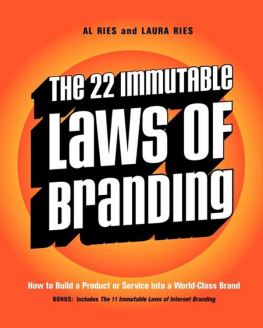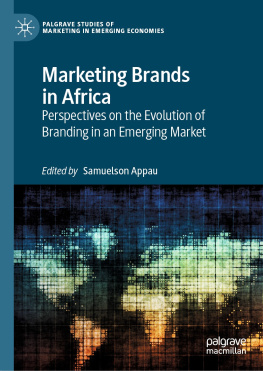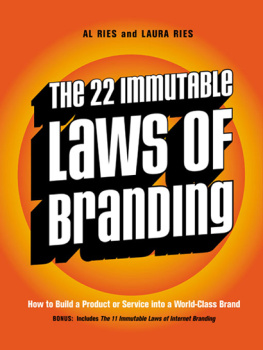Dedicated to Mary Lou and Scott.
Introduction
What is branding? From a business point of view, branding in the marketplace is very similar to branding on the ranch.
A branding program should be designed to differentiate your product from all the other cattle on the range. Even if all the other cattle on the range look pretty much alike.
Successful branding programs are based on the concept of singularity. The objective is to create in the mind of the prospect the perception that there is no other product on the market quite like your product.
Can a successful brand appeal to everybody? No. The same concept of singularity makes certain that no one brand can possibly have a universal appeal.
Yet, broadening the base, widening the appeal, and extending the line are all popular trends in marketing. The same forces that try to increase a companys market share are also the forces that undermine the power of the brand.
Its the difference between selling and branding. Could you sell a $100 Rolex watch? Sure, you could probably sell millions of them and in the process increase sales of Rolex watches. But what would happen in the long term to the Rolex brand? A cheap Rolex would ultimately kill the expensive Rolex brand.
The same principles apply to almost every aspect of marketing. In the short term, conventional marketing strategies (expansion and line extension) can increase sales, but in the long run they usually undermine the power of the brand and decrease sales.
Conventional marketing is based on selling when it should be based on branding. Marketing is not selling. Marketing is building a brand in the mind of the prospect. If you can build a powerful brand, you will have a powerful marketing program. If you cant, then all the advertising, fancy packaging, sales promotion, Web designs, and public relations in the world wont help you achieve your objective.
Marketing is brand building. The two concepts are so inextricably linked that its impossible to separate them. Furthermore, since everything a company does can contribute to the brand-building process, marketing is not a function that can be considered in isolation.
Marketing is what a company is in business to do. Marketing is a companys ultimate objective. Thats why everyone who works in a corporation should be concerned with marketing, and specifically, with the laws of branding.
If the entire company is the marketing department, then the entire company is the branding department.
As illogical as it might seem, we can visualize a time when the marketing concept itself will become obsolete, to be replaced by a new concept called branding.
What is accelerating this trend is the decline of selling. Selling, as a profession and as a function, is slowly sinking like the Titanic . Today most products and services are bought, not sold. And branding greatly facilitates this process. Branding pre-sells the product or service to the user. Branding is simply a more efficient way to sell things.
That old expression Nothing happens until somebody sells something is being replaced by todays slogan, Nothing happens until somebody brands something.
Take a supermarket or a drugstore with brands lined up on the shelves. A lot of buying takes place as customers pick and choose among various brands. But wheres the selling?
The selling is in the brand. In this age of multimedia, the verbal endorsement of a productessentially, its guaranteeis represented by the brand name rather than by the personal recommendation of a salesperson.
What has been true for years in the supermarket is now beginning to catch on across the marketing landscape. Except at the cosmetic counters, most department stores sell products without the help of a salesclerk. The salesclerks are there to help ring up sales, period.
More and more car dealers are adopting the one-price, no-haggling Saturn strategy. Bookstores, pharmacies, bed-and-bath outlets are almost all self-service retailers. Even shoe stores are moving in that direction.
The retailing world is becoming one big Wal-Mart Supercenter. Products are stocked in depth, artfully arranged, and reasonably priced, but never sold.
Theres a seismic shift taking place in the world of business. The shift from selling to buying. This shift is enhanced by, accelerated by, and caused by brands.
The essence of the marketing process is obviously building a brand in the minds of consumers. But what, you may ask, is a brand?
Some managers believe that brands possess unique identities and qualities separate and distinct from their company or product names.
They made their name into a brand, said one analyst about a companys successful marketing program.
They made their name into a brand? What does this statement mean? In truth, nothing. On paper, there is no difference between a company or product name and a brand name.
Obviously, marketing people have all sorts of definitions for company names, division names, brand names, and model names, not to mention subbrands, megabrands, flanker brands, and other variations.
When you look inside the mind of the prospect, however, all of these variations disappear. Imagine a customer saying to a friend, What do you think of this new flanker brand?
Not much. I stick with megabrands or subbrands.
People dont talk that way. Nor do they think that way. To paraphrase Gertrude Stein, A brand is a brand is a brand.
A brand name is nothing but a word in the mind, albeit a special kind of word. A brand name is a noun, a proper noun, which like all proper nouns is usually spelled with a capital letter.
Any and every proper noun is a brand, whether its owned by an individual, a corporation, or a community. Patagonia is a brand name for a clothing line, but its also a brand name for the tourist industries of Argentina and Chile interested in promoting travel to this pristine and beautiful place.
Philadelphia is a brand name for the leading cream cheese, but its also a brand name for the City of Brotherly Love.
Brands are not limited to the 2.5 million trademarks registered with the U.S. government. Nor the additional millions of names and logotypes registered with other countries around the world.
Any proper noun is a brand. You are a brand. And if you want to be truly successful in life, you should consider yourself a brand and follow the laws of branding outlined in this book.
The power of a brand lies in its ability to influence purchasing behavior. But a brand name on a package is not the same thing as a brand name in a mind.
The customer who stops at a 7-Eleven to pick up a loaf of bread and a quart of milk usually ends up purchasing two branded products. Yet there might be little or no brand preference in the buyers mind. Its just a quart of milk and a loaf of bread. Both commodity purchases.
Yet the same customer might also buy a six-pack of beer and a carton of cigarettes. Chances are high that the customer will search out a particular brand of beer and a particular brand of cigarettes to buy.
Conventional wisdom suggests that beer and cigarettes are different from bread and milk. Beer and cigarettes are brand buys. Bread and milk are commodity purchases.
While this may be literally true, it overlooks an important consideration. You can build a brand in any category, including bread and milk, as long as you follow the laws of branding. Some companies already have done so with brands like Lactaid in milk, Silk in soy milk, and Earth Grains in bread.
If there ever was a commodity category, its HO, otherwise known as water. Since almost every person in America has access to good, clean water out of a tap, there is no need to buy water from a store, but many people do.












